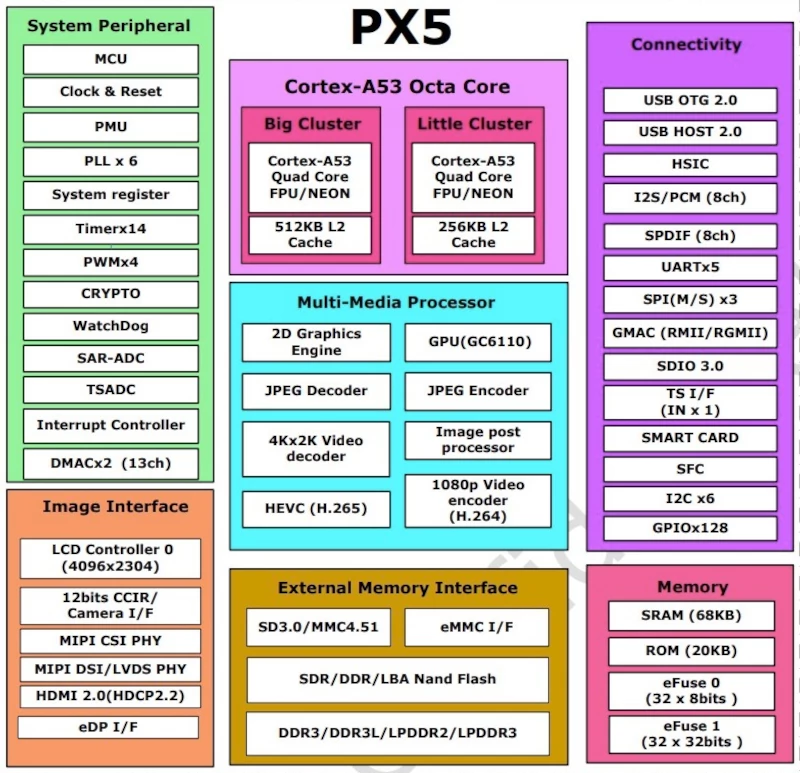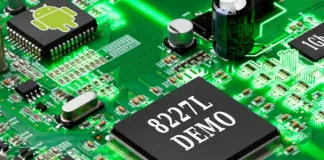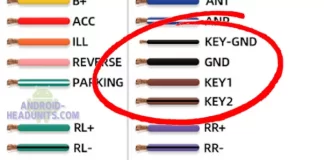The PX5 processor is a standard high-performance processor found in many Android headunits.
PX5 Processor Answers
Is the PX5 a fast processor?
Yes. The PX5 is a modern design, fast processor for Android headunits
Is the PX5 a good processor for an android head unit?
Yes. The PX5 is a good choice for an Android headunit. While the PX5 has recently become very popular, the newer models use the upgraded PX6 processor.
Do the PX5 android headunits have more than 2 GB RAM?
Yes. The PX5 Android headunits have 4 GB RAM.
Is the PX5 processor a quad-core?
No. The PX5 is an octa-core processor, and this is a processor with 8 ARM cores.
Can you still get the PX5 based android headunits?
Yes, you can still find the PX5-based Android headunits. These PX5s tend to be old stock, and most models that employed the PX5 now use the upgraded PX6 processor instead.
Purposeful Design
The PX5 processor is notable for its design purpose. The PX5 was destined for the Android headunits, and this one is special, unlike the many processors used previously to power the head units designed for phones. Savings can be made by only building features that an Android headunit would benefit from and excluding all the phone-specific features.
Cut out the fat
A typical Android headunit processor previously relied on using chips designed for phones. An Android head unit does not need security with fingerprint detection, megapixel camera support, AI for filters, and many other phone-specific details. Not including these supports in a processor core can reduce the size and therefore reduce the cost, or the same size die can be used for more cores and coprocessors.
The PX5 design statement
PX5 is a low power, high performance processor for in-vehicle infotainment system. It supports
rockchip.com
android, based on the ARM Cortex architecture.
This is encouraging. The market has been crying out to see the time and money put into producing a new processor designed for use in an Android headunit is what the market has been crying out for. Gone is the need to re-purpose the phone-specific processors, with their design features at odd with the Android headunits. Chinese manufacturers can build headunits with a dedicated processor for the job.
Octa-Core
The Octa Core setup is made up of 8 ARM Cortex-A53 cores. There are 2 clusters evenly split into 4 cores each. The first cluster is in the high-performance (big cluster), and the other is optimized for low power(little cluster)—an interesting 1:1 split of the clusters.
The eight Cortex-A53 cores are configured in a big.LITTLE pair to improve power saving and boost performance. The architecture of ARM Cortex-A53 is based on the Armv8-A instruction set, giving a 64-bit processing capability.
PX5 Processor block diagram

NEON coprocessor
The PX5 octa-cores include the ARM NEON FPU/Coprocessors, as seen in the block diagram. The ARM NEON SIMD technology employed in the PX5 design is used to improve the multimedia user experience. This performance boost is brought by accelerating audio and video encoding/decoding, user interface, 2D/3D graphics, and gaming apps—all ideal features for speed boosting in an Android headunit.
Graphics
The PX5 has both 2D and 3D graphics processing capabilities.
3D Graphics Engine features:
- Base handheld architecture fully Microsoft DirectX™ 9.3 compliant
- OpenGL 3.1 compliant
- OpenGL ES 3 compliant
- Dedicated processor for Rogue core firmware execution
2D Graphics Engine features:
- BitBlit with Stretch Blit, Simple Blit and Filter Blit
- Color fill with gradient fill and pattern fill
- Line drawing with anti-aliasing and specified width
- High-performance stretch and shrink
- Monochrome expansion for text rendering
- ROP2, ROP3, ROP4
- Alpha blending modes, including global alpha, per pixel alpha, porter-duff, and fading
- 8K x 8K input and 2K x 2K output raster 2D coordinate system
- Arbitrary degrees rotation with anti-aliasing on every 2D primitive
- Blending, scaling, and rotation are supported in one pass for Bitbilt
PX5 GHz
The PX5 processor is clocked at 1.5 GHz, a respectable clock rate for an 8-core Cortex-A53 processor.
Support for RAM
The PX5 supports up to 2 ranks (chip selects), giving 4 GB maximum address space.
This means the maximum RAM for a PX5-powered Android head unit is 4 GB.
4 GB RAM is a respectable amount. The PX5, capable of addressing the standard DDR3-1066 RAM, will help keep apps moving quickly while maintaining low costs. There is faster RAM available, but this processor is targeted at a competitive, cost-focused market. The market needs cheap-to-produce, high-performance components. Using 4 GB, DDR3 1066 will keep the cost down but boost performance over the earlier designs.
USB Support
You can’t get anywhere without USB ports. Every Android head unit has them and needs them. The universal connection for the broadest range of add-ons for an Android head unit is by USB. The PX5 has USB2 and USB2OTG support and no USB3 for the Android Headunits.
USB Host2.0
- Embedded 2 USB Host2.0 interfaces
- Compatible with USB Host2.0 specification
- Supports high-speed(480 Mbps), full-speed(12 Mbps) and low-speed (1.5 Mbps) mode
- Provides 16 host mode channels
- Support periodic out channel in host mode
USB OTG2.0
- Compatible with USB OTG2.0 specification
- Supports high-speed(480 Mbps), full-speed(12 Mbps) and low-speed (1.5 Mbps) mode
Respectable but nothing outstanding for USB and the PX5, functional and compatible with your common add-ons.
PX5 overall
The PX5 was groundbreaking in 2016, making many modern Android headunit possible. Without the new PX5 processor, the old designs would still be based on phone chips. With these chips’ wasteful clock cycles and unnecessary extra production costs, there was room for change. While the PX6 has taken over as an almost drop-in replacement for the PX5, it is still considered a modern processor for an Android headunit. If you are looking at a new Android head unit, you will unlikely find a PX5-based unit now. Most current Android headunit models have been upgraded to PX6 or are using later designs of processor cores.
Old Stock
If you see new PX5 octa-core processor-powered Android headunits, they will be old stock, or there will be an update deep in the description to describe the use of the new processor (PX6).







